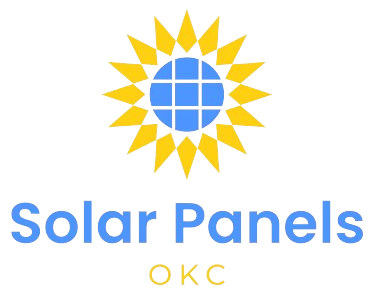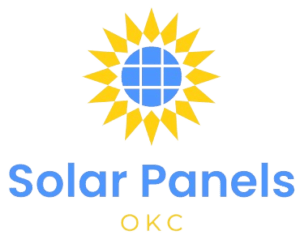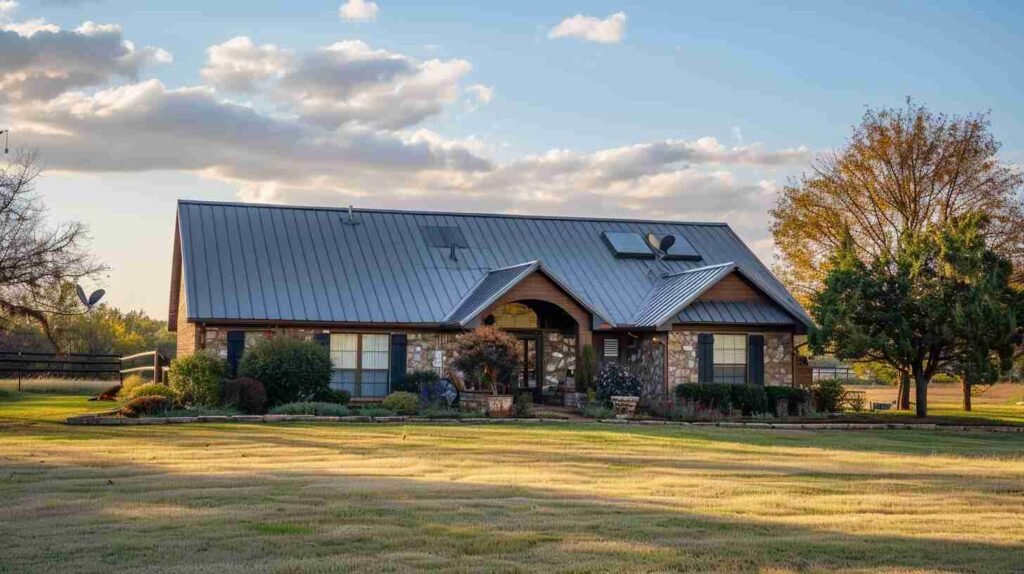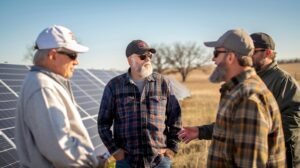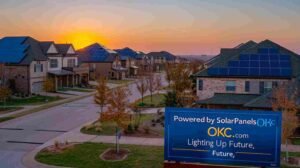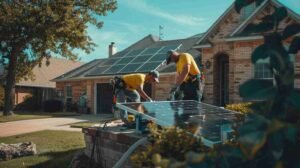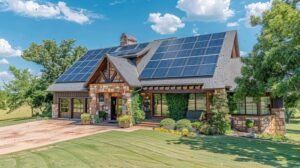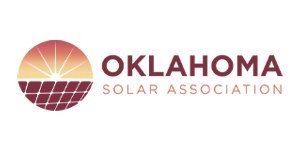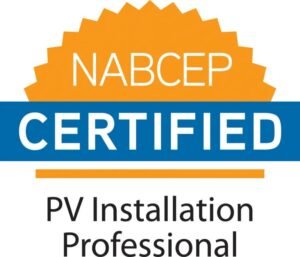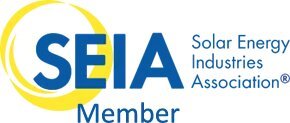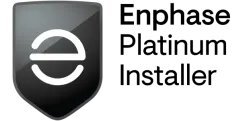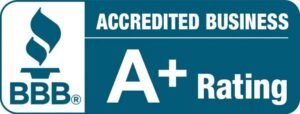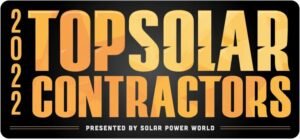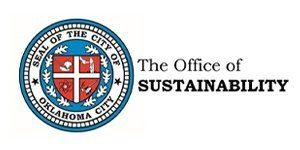Installing solar panels transcends simply enhancing your home’s appearance; it signifies a dedication to sustainable energy. This process involves a thorough examination of your roof’s structure along with keeping abreast of the latest developments in solar technology.
The best and easiest roofs for solar installation? Metal roofs, without a doubt.
Call now to get a free quote
Key Points to Remember
- Properly evaluating roof types is critical for a seamless solar panel installation.
- Accessing financial incentives can significantly ease the cost of going solar.
- Ensuring regular maintenance and seeking expert advice are pivotal for enjoying the long-term advantages of solar energy.
Types of Solar Panels
In Oklahoma City, residents have access to three primary types of solar panels: monocrystalline, polycrystalline, and thin-film.
- Monocrystalline Panels: These are known for their high efficiency and durability, typically recognized by their uniform dark look and rounded edges. Their efficiency can often exceed 20%, making them a popular choice despite their higher cost.
- Polycrystalline Panels: These panels are identifiable by their bluish hue and square shape. They are less expensive but tend to have slightly lower efficiency rates, usually in the range of 15% to 17%.
- Thin-Film Panels: As the most lightweight and flexible option, thin-film panels are less efficient than both monocrystalline and polycrystalline, with efficiency ratings generally between 10% and 13%.
Energy Efficiency of Solar Panels
Energy efficiency is a vital consideration for solar panels as it directly affects the energy production and overall savings on electricity costs.
- Efficiency: It’s the percentage of sunlight that is converted into usable electricity. For Oklahoma City homeowners, higher efficiency means more energy generation in less space, which is particularly important in urban settings with limited roof areas.
- Factors Influencing Efficiency: Several factors affect solar panel efficiency, including the type of panel, the quality of installation, orientation, and angle to the sun, as well as the amount of sunlight received.
Solar Panel Technology Advancements
Our understanding of solar technology is continually evolving, leading to more efficient and cost-effective solutions.
Recent Advancements: Research has improved solar panel designs, such as the development of bifacial panels that can capture sunlight from both sides, and PERC (Passivated Emitter and Rear Cell) technology, which enhances efficiency and performance.
Future of Solar Panels: In Oklahoma City and beyond, ongoing innovation promises the development of materials and designs that can further increase solar panel lifespans, reduce costs, and make solar energy more accessible to all residents.
Evaluating Roof Types for Solar Installations
Chad Stickrod of SolarPanelsOKC.com explains that for solar installations in Oklahoma City, it’s crucial to examine the roofing materials and structures for their PV compatibility. He notes that metal roofs are the best and easiest for solar panel setups, with asphalt shingle roofs being the second easiest.
This assessment ensures a successful solar panel installation, emphasizing the importance of choosing the right type of roof (if you have that option) to get the most out of your photovoltaic system.
Residential Roof Considerations
For homeowners in Oklahoma City, the choice of roofing material is essential in planning a solar installation. Most common residential roof types, such as asphalt shingles, can support solar panels effectively. However, certain materials like slate or clay tiles may require special mounting equipment to avoid damage during installation.
Asphalt Shingle Roofs: These are the most straightforward for solar panel installations. Brackets and mounting systems can be easily integrated with minimal risk of leakage or structural damage.
Metal Roofs: Metal roofs with standing seams are ideal for solar panels because the mounting systems can attach to the seams without drilling holes, making the process simpler and preserving the integrity of the roof.
Tile Roofs: While durable, they could be more challenging for installers. Special hooks and care are necessary to ensure the tiles aren’t broken.
Homeowners should ensure their roofs are in good condition before proceeding with solar panel installation. The age of the roof and the expected lifespan after installation are critical factors to consider.
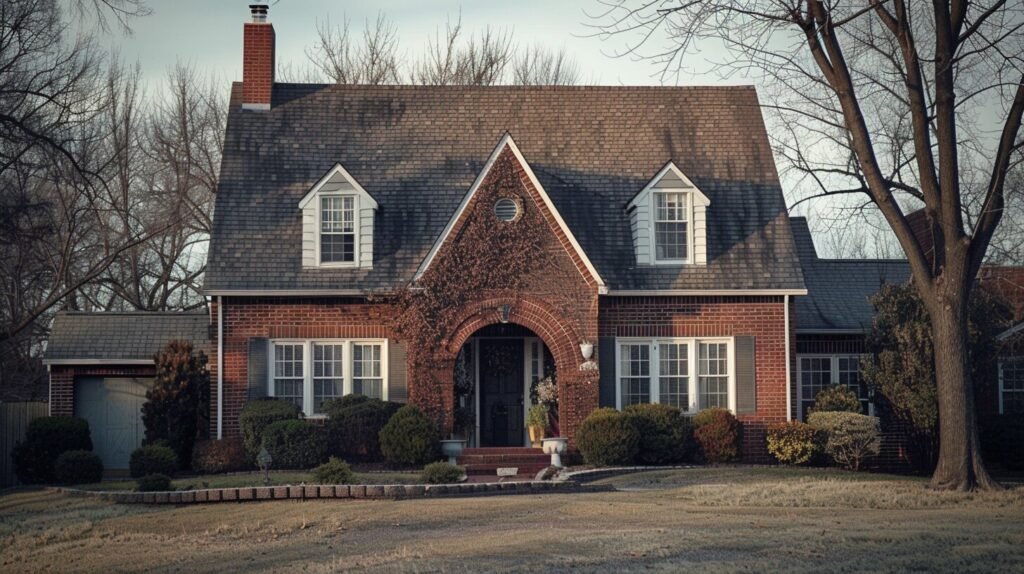
Commercial Roofing for Solar
Businesses require a different approach to solar installations due to the varying shapes and sizes of commercial buildings. Flat roofs are prevalent in commercial setups and necessitate a unique installation strategy.
- Flat Roofs: These may need additional tilt frames to optimize sun exposure. Ensuring proper drainage and avoiding ponding water is also crucial to maintain the roof’s integrity. Many installations on flat commercial roofs use ballast mount systems, which do not penetrate the roof membrane.
- Metal Roofs on Commercial Buildings: Similar to residential metal roofs, are favorable for solar installations. Their durability and ease of attaching solar panels without penetration make them an attractive option for businesses.
For both residential and commercial properties in Oklahoma City, a thorough roof evaluation by a qualified solar installer should be the first step in transitioning to solar energy.
Installation Process Details
The solar panel installation process requires precision and expertise.
Here’s what we need to anticipate during the procedure:
- Site Evaluation:
- Assessment of the roof’s structure and sun exposure.
- Ensure compliance with local regulations and codes.
- Design and Engineering:
- Tailoring the system design to our roof’s specifications.
- Calculating the optimal arrangement for energy efficiency.
- Permits and Documentation:
- Securing necessary permits from local Oklahoma City authorities.
- Completing any utility company agreements.
- Physical Installation:
- Installation of racking systems to support solar panels.
- Mounting of solar panels onto the racking system.
- Wiring and configuring the system for operation.
- Inspection and Interconnection:
- Undergoing inspection from a local official to ensure safety and compliance.
- Connecting the system to the grid with utility company coordination.
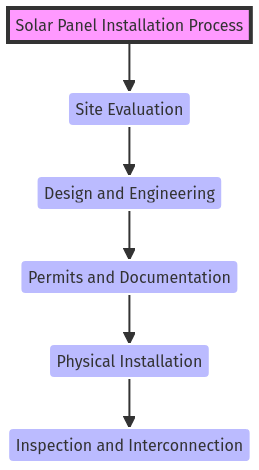
Pricing and Affordability
The cost of solar panels can vary widely, typically ranging from $8,500 to $30,500 for residential systems.
A critical factor determining the price is the cost per watt, which, on average, is about $3.00 per watt installed.
This varies based on the type of solar panel, the size of the system, and the complexity of your roof type. For those of us in Oklahoma City, local market conditions will also impact overall costs.
Solar Financing Options
We have access to various solar financing options that can make transitioning to solar power more affordable.
These options include solar loans, which allow us to spread the cost of solar panels over time. As the owner of the system, we can still benefit from solar incentives like the Federal Residential Clean Energy Credit.
Solar leases or power purchase agreements (PPAs) are alternatives where you don’t own the panels but agree to pay for the power they generate, usually at a lower rate than the local utility’s.
Understanding the Payback Period
The payback period is the time it takes for the energy savings to cover the initial cost of the solar panel system. In Oklahoma City, the average payback period varies but could be approximately 8 to 10 years, depending on specific variables such as energy consumption patterns and local electricity rates.
Federal Solar Tax Credit
We can take advantage of the Federal Solar Tax Credit also known as the Investment Tax Credit (ITC), which allows us to deduct 30% of the cost of installing a solar energy system from our federal taxes.
This substantial credit applies not just to the solar panels but also to the entire cost including equipment, labor, and permitting fees.
It’s important to note this credit is available for systems installed before the end of 2032, after which the percentage will reduce annually until the Credit’s expiration in 2035.
Local Incentives & Rebates
In addition to the federal credit, you may be entitled to certain local incentives and rebates. While these can vary widely, they often include state tax credits, cash rebates, and solar renewable energy certificates (SRECs).
Oklahoma’s specific incentives may also include utility-based rebates or performance-based incentives, which reward us for the energy produced by our solar panels. To stay up to date on the latest offerings specific to Oklahoma City, you should check with local energy providers and government agencies dedicated to renewable energy.
Maximizing Solar System Performance
To maximize the performance of our solar systems, we consider a range of factors from the solar panel type to the size of the system:
- Type of solar panel: Monocrystalline panels often exceed 20% efficiency, while polycrystalline panels range between 15-17%. Thin-film panels typically have lower efficiencies, at around 11%.
- System size: The size of our solar system should match our energy needs. A larger system will generate more power but requires a proportional investment.
- Orientation and tilt: We ensure our panels are installed at an optimal angle to capture the most sunlight.
- Shade and environmental factors: We assess local conditions and plan our installations to minimize shading.
Here is a quick reference table for solar panel efficiencies:
| Solar Panel Type | Average Efficiency |
|---|---|
| Monocrystalline | > 20% |
| Polycrystalline | 15-17% |
| Thin-film | ~11% |
By utilizing solar panels with higher efficiency, we can make better use of limited rooftop space and generate more electricity per square foot.
Impact on Electricity Bills
The efficiency of our solar panels directly correlates to our electricity bills. Here’s how:
- Higher efficiency means more power: This translates to more electricity generated and, hence, greater savings on our bills.
- Data-driven insights: By monitoring our system’s performance data, we can make informed decisions about energy use and additional enhancements to our system.
Solar Panel Maintenance Tips
Regular Cleaning: Keeping panels clean is vital. Dust, dirt, and other residues can significantly diminish solar panel efficiency. We recommend cleaning your solar panels two to four times a year to maintain optimal operation. Use a soft brush or cloth and a mild detergent to gently wipe the panel surface.
Dealing with Wear and Tear
Periodically replacing worn out parts is part of a good maintenance routine. Always keep track of your manufacturer and installer warranties, which can cover damage for a limited period, usually 10 to 25 years.
Understanding Solar Warranties
Solar warranties are essential for protecting your investment against manufacturing defects or performance issues. There are two main types of warranties:
- Product Warranty: Typically, solar panels come with a product warranty that lasts for about 25 years. This warranty ensures that the panels themselves are free from defects and will function as promised, covering the costs for repair or replacement should a problem arise. Our solar systems are accompanied by a 25-year product warranty that covers labor, shipping, and all parts.
- Performance Warranty: A performance warranty guarantees that the solar panels will produce a certain percentage of their rated power after a certain number of years. For instance, it’s common for panels to be guaranteed to operate at no less than 92% of their total power at the end of the warranty period. We ensure a degradation rate of no more than 0.25% per year, securing your system’s output for years to come.
Call now to get a free quote
Service Agreements
Service agreements are contracts between you and the solar company that outline the scope of maintenance and servicing the company will provide over a given period. Here’s what they typically cover:
- Routine Maintenance: Regular check-ups to ensure everything is running smoothly, often on an annual basis.
- Repairs: Coverage for issues not included under the product warranty, which might include workmanship errors or unforeseen damage.
- Insurance: Some service agreements might include provisions that go beyond the warranty, potentially covering loss or damage due to environmental factors or accidents.
Ready to Harness the Sun?
Embrace the power of solar energy with Solar Panels OKC. Call us today to find the perfect solar solution for your home or business. Let’s light up your world, the sustainable way.
